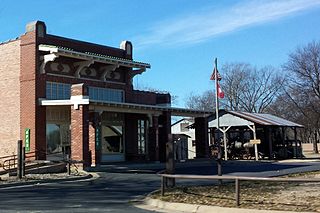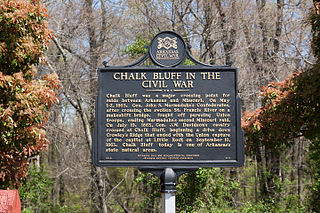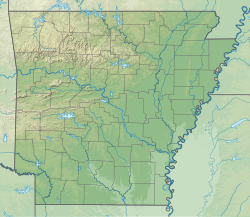
Scott is an unincorporated community and census-designated place (CDP) in Lonoke and Pulaski counties in the central part of the U.S. state of Arkansas. Per the 2020 census, the population was 97. It is part of the Little Rock–North Little Rock–Conway Metropolitan Statistical Area.
The Battle of Bayou Fourche, also known as the Engagement at Bayou Fourche, was fought on September 10, 1863, near Little Rock, Arkansas, and was the final battle of the Little Rock campaign during the American Civil War. A Union force commanded by Major General Frederick Steele had begun an advance from Helena, Arkansas, west towards Little Rock in August. The Union campaign met light resistance aside from the Battle of Bayou Meto, while Confederate troops under Major General Sterling Price built fortifications on the other side of the Arkansas River from Little Rock.

Central Arkansas, also known as the Little Rock metro, designated by the United States Office of Management and Budget as the Little Rock-North Little Rock-Conway Metropolitan Statistical Area, is the most populous metro area in the U.S. state of Arkansas. With an estimated 2020 population of 748,031, it is the most populated area in Arkansas. Located at the convergence of Arkansas's other geographic regions, the region's central location make Central Arkansas an important population, economic, education, and political center in Arkansas and the South. Little Rock is the state's capital and largest city, and the city is also home to two Fortune 500 companies, Arkansas Children's Hospital, and University of Arkansas for Medical Sciences (UAMS).
The Battle of Chalk Bluff, also known as the Skirmish at Chalk Bluff, was a military engagement of the American Civil War. The battle was fought near Chalk Bluff, northwest of St. Francis, where U.S. Brigadier General William Vandever, commanding the Second Division of the Army of the Frontier, was repulsed in an attempt to prevent Confederate General John S. Marmaduke's Division from crossing the St. Francis River. Though a Confederate victory, Marmaduke suffered considerable casualties and his momentum had been checked, forcing him to abandon his second expedition into Missouri.

The Battle of Chickasaw Bayou, also called the Battle of Walnut Hills, fought December 26–29, 1862, was the opening engagement of the Vicksburg Campaign during the American Civil War. Confederate forces under Lt. Gen. John C. Pemberton repulsed an advance by Union Maj. Gen. William T. Sherman that was intended to lead to the capture of Vicksburg, Mississippi.

The Battle of Honey Springs, also known as the Affair at Elk Creek, on July 17, 1863, was an American Civil War engagement and an important victory for Union forces in their efforts to gain control of the Indian Territory. It was the largest confrontation between Union and Confederate forces in the area that would eventually become Oklahoma. The engagement was also unique in the fact that white soldiers were the minority in both fighting forces. Native Americans made up a significant portion of each of the opposing armies and the Union force contained African-American units.
The Camden Expedition was the final campaign conducted by the Union Army in south Arkansas during the Civil War. The offensive was designed to cooperate with Major-General Nathaniel P. Banks' movement against Shreveport.

The Camden Expedition Sites is a national historic landmark consisting of nine nationally significant historic places in southwest Arkansas where events of the Union army's disastrous Camden Expedition of 1864 occurred during the American Civil War. The Union was attempting to take over Shreveport, Louisiana. Each of the sites are individually listed on the National Register of Historic Places. It was designated a national historic landmark on April 19, 1994.

Fort Southerland, also known as Redoubt E and possibly Fort Diamond, is a redoubt built during the American Civil War to protect Camden, Arkansas. Confederate forces built it along with four other redoubts in early 1864 after a Union victory in the Little Rock campaign the previous year. Fort Southerland is about the size of a city block and is roughly oval. It could hold three cannons. When Union forces captured Camden in April 1864 during the Camden Expedition, they improved the defenses of the five redoubts, which were not sufficient for proper defense of the city. After the Confederates retook Camden later that month, they continued to improve the city's defenses.

The Prairie D'Ane Battlefield, also known as Prairie D'Ann Battlefield or Prairie De Ann Battlefield in anglicized forms, was the site of the Civil War Battle of Prairie D'Ane, one of the engagements in southwestern Arkansas of the Union's Camden Expedition of 1864. It was listed on the National Register of Historic Places in 1974, and, with other sites, is part of the Camden Expedition Sites National Historic Landmark. It was declared part of the National Historic Landmark in 1994.
The Port Gibson Battlefield is the site near Port Gibson, Mississippi where the 1863 Battle of Port Gibson was fought during the American Civil War. The battlefield covers about 3,400 acres (1,400 ha) of land west of the city, astride Rodney Road, where Union Army forces were establishing a beachhead after crossing the Mississippi River in a bid to take the Confederate fortress of Vicksburg. The Union victory secured that beachhead and paved the way for the eventual fall of Vicksburg. A 2,080-acre (840 ha) area surrounding part of the site was listed on the National Register of Historic Places in 1972, and a larger area was designated a National Historic Landmark in 2005. In 2009, the battlefield was designated by the Civil War Preservation Trust as one of its Top 10 most endangered Civil War battlefields. In 2011, the Civil War Preservation Trust was renamed the Civil War Trust, which in 2018 became a division of the American Battlefield Trust. The Trust and its partners have acquired and preserved 644 acres (2.61 km2) of the Port Gibson battlefield.
8th Missouri Cavalry Regiment was a cavalry unit from Missouri that served in the Union Army during the American Civil War. The regiment was formed between 6 August and 15 September 1862. The regiment fought at Prairie Grove and Van Buren in 1862. The unit participated in Frederick Steele's expedition to Little Rock in 1863, fighting at Brownsville, Bayou Meto, and Bayou Fourche. From 1863 to 1865, the regiment remained in Arkansas, going on expeditions to suppress Confederate raiders and other occupation duties. The unit was mustered out of service on 20 July 1865. In January 1863, the regiment committed what has become known as the Huntsville Massacre.
The Battle of Bayou Meto, also known as the Battle of Reed's Bridge, was fought near present-day Jacksonville, Arkansas, along the Bayou Meto River, on August 27, 1863. During the American Civil War, Union forces left Helena, Arkansas, to move against the Confederate-held state capital of Little Rock. Part of the Union command, under Brigadier General John W. Davidson, defeated Confederate cavalry commanded by Brigadier General John S. Marmaduke on August 25, in the Battle of Brownsville. After the action at Brownsville, the Confederates fell back to the Bayou Meto. Union attacks on August 27 succeeded in pushing Marmaduke's men back across the bayou, but were unable to break the Confederate line. Davidson withdrew back to Brownsville after the fighting. The Union advance resumed on September 6, and Little Rock surrendered on September 10, after the Battle of Bayou Fourche. Tensions exacerbated during the action at Bayou Meto contributed to the Marmaduke-Walker duel, during which a Confederate general was killed. In 2002, part of the battlefield was listed on the National Register of Historic Places as the Bayou Meto Battlefield.

Chalk Bluff was an unincorporated community in Clay County, Arkansas, United States, approximately two miles (3 km) northwest of St. Francis. The town was formed in the 1820s at the point where the St. Francis River cuts through Crowley's Ridge from west to east. The name of the community was derived from the white clay bluff created by this crossing. The founder of the community was Abraham Seitz, who established and operated a ferry crossing and general store in the area from the 1830 until it was destroyed during the Civil War. The community occupied a strategic location and was often referred to in the reports of Union and Confederate forces vying for control of Northeast Arkansas during the war. Several skirmishes occurred near the ferry crossing, one of which was significant it enough to become known as the Battle of Chalk Bluff, which took place in early May 1863. The town was abandoned following the Civil War and most residents moved to the new railroad town, St. Francis, Arkansas. The location was listed on the National Register of Historic Places in 1974.
The Civil War Trust's Civil War Discovery Trail is a heritage tourism program that links more than 600 U.S. Civil War sites in more than 30 states. The program is one of the White House Millennium Council's sixteen flagship National Millennium Trails. Sites on the trail include battlefields, museums, historic sites, forts and cemeteries.

The Helena batteries, also known as the Union batteries at Helena, is a series of fortifications that were built in Helena, Arkansas. The earthworks were hastily erected in 1863 by Federal occupation forces during the American Civil War. The four hilltop batteries—A, B, C, and D—overlooked the roads leading into the town and played a significant role in the Battle of Helena that resulted in a strategic Union victory and secured the Arkansas side of the Mississippi River for the United States. Listed individually in the National Register of Historic Places, the batteries are part of the Helena Battlefield.
The Battle of Brownsville was fought on August 25, 1863, near what is now Lonoke, Arkansas, between Union forces led by Colonel Washington Geiger and Confederate troops under Brigadier General John S. Marmaduke. Union forces commanded by Major General Frederick Steele were advancing from Helena, Arkansas, towards Little Rock, the state capital of Arkansas. Confederate Major General Sterling Price ordered cavalry led by Marmaduke and Brigadier General Lucius M. Walker to Brownsville in response to the Union advance.
The Memphis to Little Rock Road was a settlement road constructed between 1819 and Reconstruction in Arkansas. The project was one of many internal improvements to assist settlement of the Old Southwest as well as military defense of the Arkansas Territory.

On September 6, 1863, near Little Rock, Arkansas, a duel was fought between John S. Marmaduke and Lucius M. Walker, two generals in the Confederate States Army. Tension had risen between the two officers during the Battle of Helena on July 4, 1863, when Marmaduke accused Walker of not supporting his force, and then retaliated by not informing Walker of a Confederate retreat. Marmaduke was later assigned to serve under Walker during a Union advance against Little Rock. Walker did not support Marmaduke during a retreat after the Battle of Brownsville, and Marmaduke questioned Walker's courage after the Battle of Bayou Meto on August 27. A series of notes passed between the two generals by friends resulted in a duel, during which Marmaduke fatally wounded Walker. Marmaduke was arrested and charged with murder, but was soon released and later the charge was dropped. He survived the war and later became Governor of Missouri. Union forces captured Little Rock later in the campaign, after the Battle of Bayou Fourche.
The Little Rock Campaign, officially known as Advance of the Union forces upon Little Rock, Arkansas, was a campaign conducted by the Union Army in Arkansas during the American Civil War. The offensive was designed to capture Little Rock.











